B2B marketing can be complex.
And unfortunately the internet is filled with generic and watered down information on how to invest in different lead generation channels, leading many B2B marketers to get it wrong. They may feel like they’re checking a channel off the list, when in reality their approach isn’t yielding any return. They’re getting it completely wrong.
This might be due to ineffective tactics, poor strategy, or a faulty approach altogether.
We’re going to break down six of the most effective B2B marketing channels, where many companies get it wrong, and how you can get the most out of it.
.gif)
Most Effective B2B Marketing Channels
1. Content Marketing
When businesses are evaluating purchase decisions, they are often focused on expertise. They need to be able to trust their partners, making content marketing a very effective B2B marketing strategy.
Content marketing is the creation and distribution of content (such as blog posts, eBooks, testimonials, videos, and case studies) in an effort to attract, nurture, and retain customers.
How Many Companies Get Content Marketing Wrong
The biggest mistake many companies make in B2B content marketing is having a poor understanding of where their content fits into the buyer’s journey. They hear the sentiment that there’s benefit in publishing consistently, so that’s what they do.
And rather than taking a customer-centric approach to content strategy, they throw together a somewhat random content calendar with generic topics they assume their target personas will be interested in. These topics are often incredibly generic and fail to effectively move readers down the buying funnel.
For example, “What is a POS (Point of Sale?)” is not going to help a CFO looking for a quality POS solution. A business decision maker doesn’t need an introduction to a subject matter they work in for a living.
But what often happens is this content may rank for a few keywords and actually generate some traffic. So the marketing team deems it a success, not realizing their work is yielding no return for their business.
I recently stumbled upon a B2B company who ranked for all kinds of “what is” key phrases. They had a ton of well-performing top of funnel content.
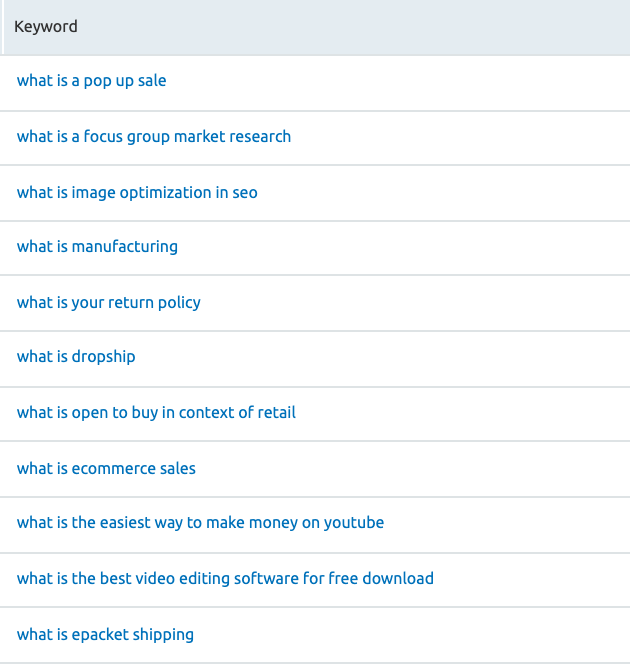
But when I browsed through their site, I saw there was no content intended to nurture or convince a prospect to work with them. I bet their traffic looks great, but wouldn’t be surprised if their revenue wasn’t where they wanted it.
How to Get Content Marketing Right
Successful content marketing does a few things really well:
First, it always begins with an intimate understanding of the target audience. When you know the needs and preferences of your ideal customers and personas, you’re able to craft content calendars that help them solve their problems at every stage of the funnel.
Make sure you have a content marketing strategy that gets results and considers the buyer’s journey. Download our free content journey worksheet:
Once you have a good understanding of your audience you’re able to plan and strategize content that meets them where they are along their journey. Every piece should have a specific goal and play a part in a persona’s journey.
You can use the template above to plan your journeys by laying out the following for each piece of content:
- Keyword(s) Targeted
- Stage of the Buyer’s Journey (Awareness, Consideration, or Decision)
- Buyer Persona
- Content Offer (What are you promoting as a call to action?)
- Content Offer Type (eBook, template, tool, etc…)
- Pillar Page or Sub-Topic
Not only does effective content marketing mean speaking to your persona at their buyer’s journey stage, it also means getting the medium right. Different types of content are better suited for different stages of the funnel.
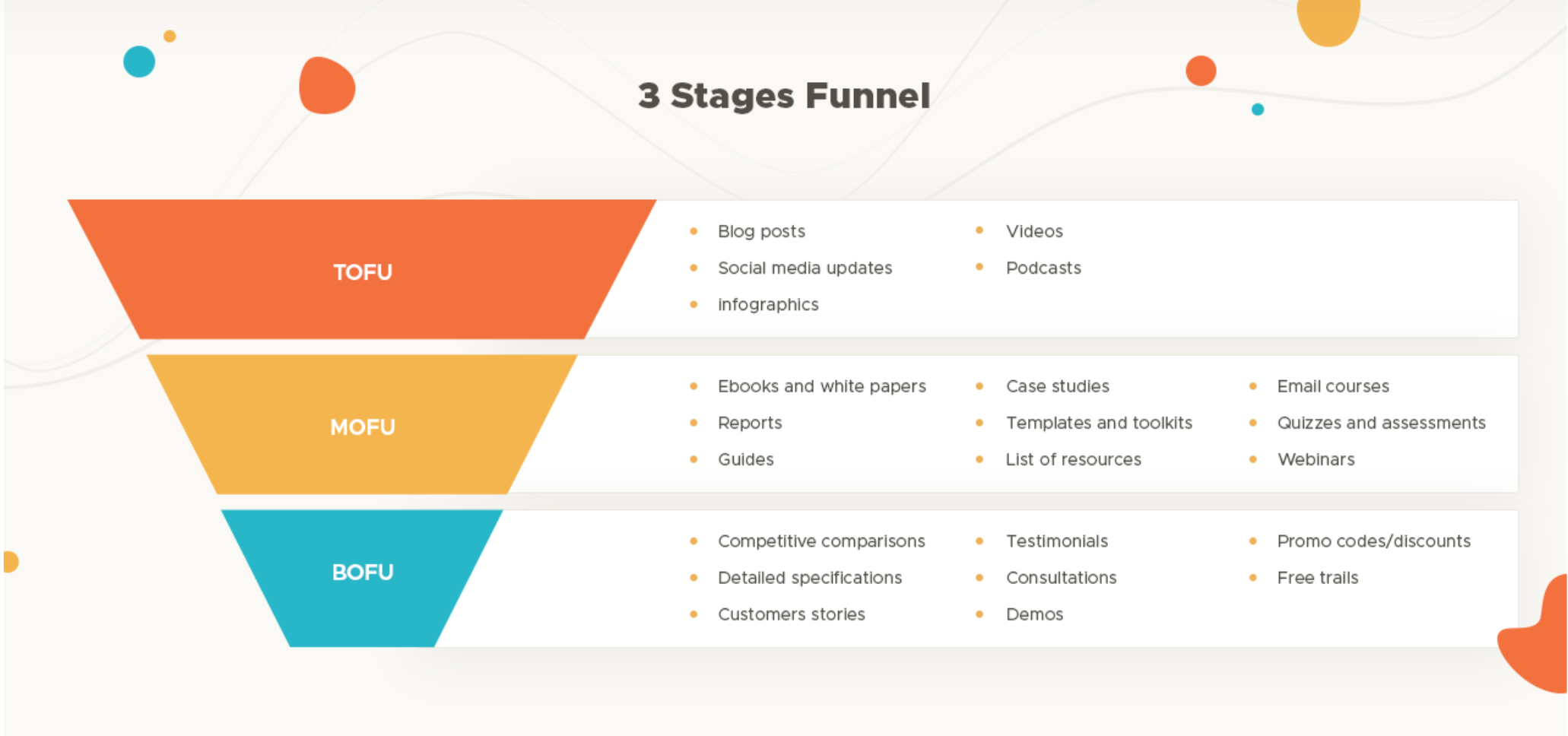 Different kinds of content are better suited for different stages of the funnel
Different kinds of content are better suited for different stages of the funnel
Highly educational blog content and infographics are great for the top of the funnel, but it’s unlikely to convert an interested buyer into a customer. Customer stories, case studies, and comparison guides carry more conversion weight.
And lastly, successful content marketing isn’t measured by traffic or # of keywords ranked for (we’ll get to SEO next). KPIs for content marketing should revolve around conversion rates, MQLs generated, and emails captured. Measure the metrics that matter for your bottom line.
A great example of excellent content marketing comes from India-based technology company, LogiNext. They are one of the fastest growing companies in Asia, thanks in large part to their commitment to thorough content marketing.
Their site features a robust blog that ranks for over 1,000 keywords. Though many of these are educational and designed to build awareness, they also rank for buying intent keywords like “on time delivery case study” and “freight case studies.”

Not only do they have a robust blog, but they’re also dedicated to white papers and case studies to nurture and convert this traffic.
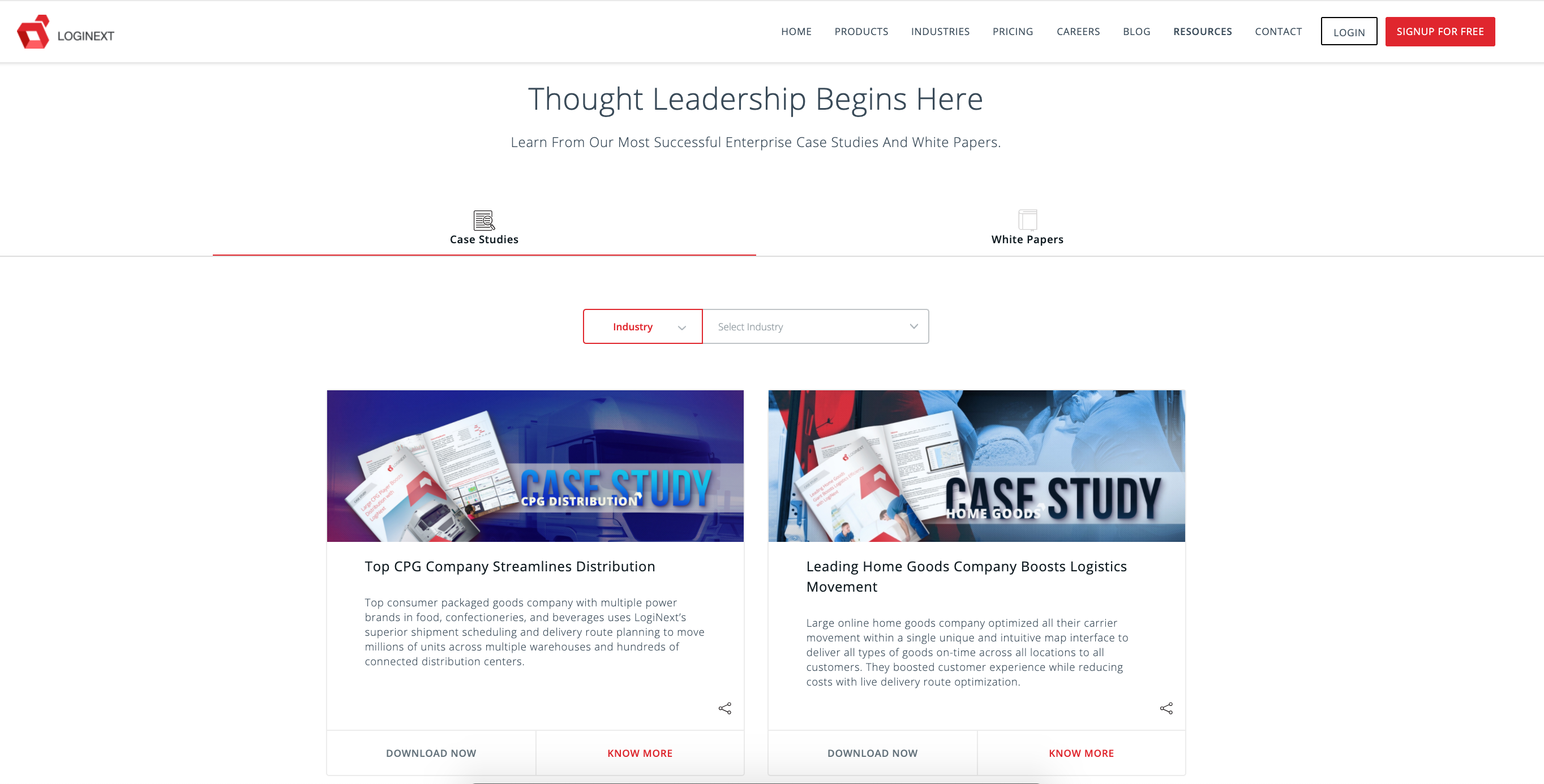
Content marketing is a powerful B2B marketing strategy when done well. Stay focused on the buying journey and cater your content to wow prospects at each touchpoint.
2. SEO (Search Engine Optimization)
SEO involves the optimization of the pages on your website to rank highly for keywords and key phrases your audience is searching for. The goal is to increase website traffic from search engines and to ultimately convert searchers to customers.
Just like content marketing, the keywords you want to rank for can vary depending on what stage of the buyer’s journey your audience is in. Because of this, SEO and content marketing often overlap.
How Many Companies Get SEO Wrong
When it comes to SEO, marketers and SEO agencies often over-emphasize the technical aspects while disregarding content strategy. Similar to content marketing, the mistake is a hyperfocus on metrics like # of referring domains (backlinks), # of keywords ranked for, and increases in organic traffic rather than leads generated and revenue growth.
SEO’s often place too much emphasis on ranking for head terms. To do so, they put everything into link building which results in receiving toxic links from PBNs and link farms that could result in a penalty from Google. Rather than creating high quality content to attract links, they pay for links or barter for shady placements on irrelevant sites.
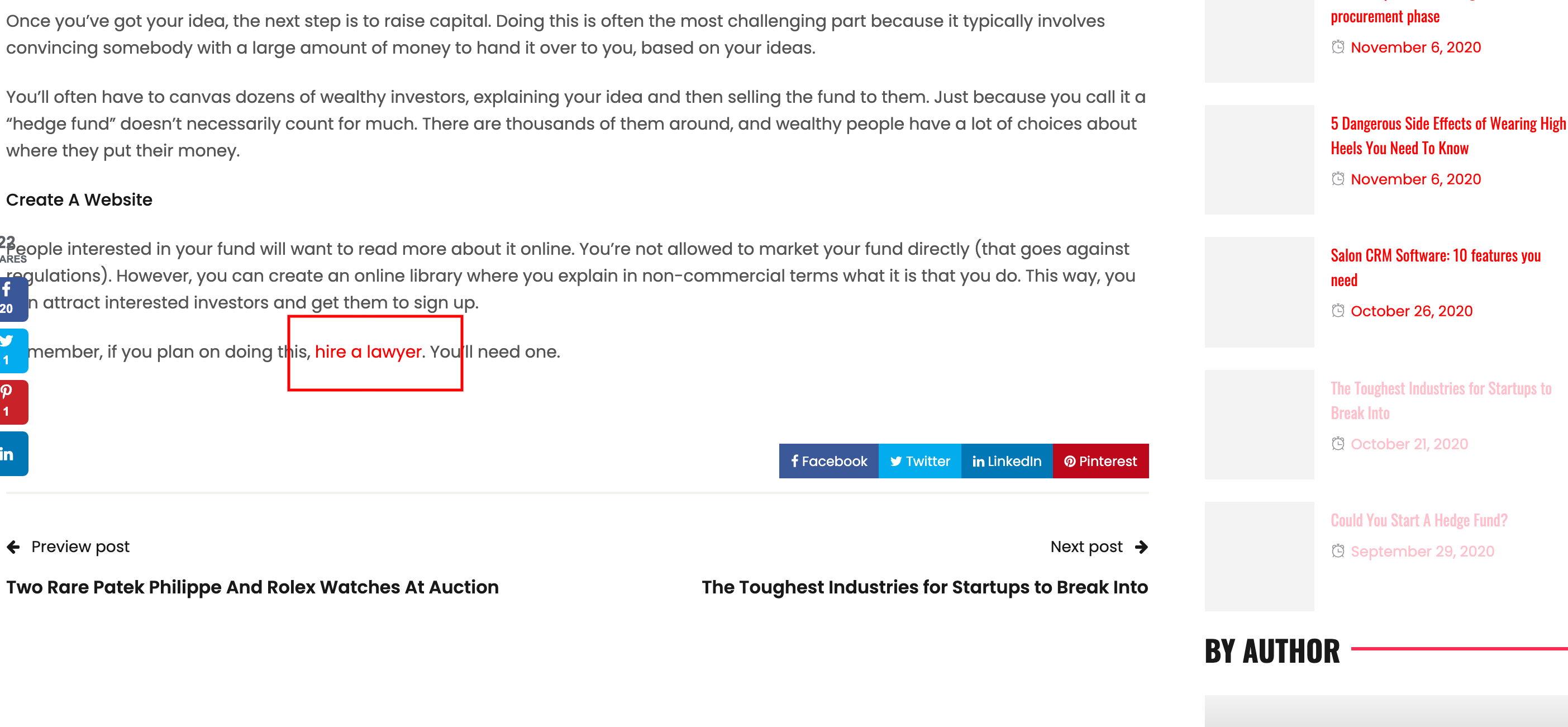
Exact match anchor text from a fashion website is unlikely to help this site rank, and may even result in a penalty.
This kind of SEO might result in some short term wins, but is dangerous and unhelpful in the long run.
How to Get SEO Right
Successful B2B SEO commits to each and every aspect. Having a technically optimized site and loads of backlinks isn’t helpful if your content isn’t valuable for the reader. And creating hundreds of well written blog posts won’t benefit you if your site isn’t technically optimized or lacks quality, relevant backlinks.
Technically optimize your site, create content that both ranks and engages readers, and be smart about building backlinks. Rather than outsourcing it, focus on earning links to your content, and pass that link equity to your primary services pages through internal links.
Our site provides a great example. We rank extremely well for the majority of our services.
But we haven’t done it through questionable link building tactics. We’ve done it by creating valuable content that ranks well and earns links naturally.
Outside of the Brew homepage, our blog content earns the majority of links.
This is successful SEO that leads to long term organic success. Don’t go after quick wins – commit to the long game.
3. Digital Advertising
Digital advertising is the perfect channel for industries that don’t have loads of popularity or search volume. It allows businesses to put their brand, their messaging, and their content in front of their target audience – no matter where they are online.
Whether it’s through display, programmatic, Facebook, LinkedIn, or Google – digital advertising can be an effective B2B marketing channel when executed well.
LinkedIn Ads are one of many digital advertising options you have.
How Many Companies Get Digital Advertising Wrong
There are a few crucial errors often made in B2B digital advertising.
The first is poor targeting. B2B companies get excited about a new ad campaign, but set it to run to an audience that’s entirely too broad.
They might check a couple of options based on location and demographic, but nothing further. They not only target based on too few attributes, but they don’t exclude irrelevant audiences either. And when it comes to display and programmatic ads, marketers allow them to run on irrelevant websites.
Social media advertising allows you to both target and exclude certain attributes.
B2B decision makers receive marketing material all day long, across the web and in their inboxes. If your solution isn’t hyper-targeted to their problems and needs, it will be overlooked.
Lastly, just like content marketing and SEO, marketers fail to understand their buyer’s journey. They run the wrong types of ads at the wrong times.
Brand awareness focused ads and free content downloads are helpful, but they’re not going to convert. They should be run to new audiences. Likewise, case study ads might not make the most sense to an audience who has never engaged before.
Utilize different types of ads at each stage of the buyer’s journey.
How to Get Digital Advertising Right
To really succeed with digital advertising, you need to know your target persona well. Broad B2B campaigns that aren’t well-targeted are a waste of money.
Hone in on every detail of your ideal customer profile. Don’t settle for location and gender. Networks like Facebook allow you to target attributes into their job title, company type, buying behaviors, and seniority. For display ads, do research into what kinds of sites they spend the most time on.
Once your audience is well-targeted, feed them ads that stop them in their tracks. Double down on the creative, optimize your copy, and send them the right message at the right time. Get creative. Don’t settle for an average ad.
Finally, always be testing. Test different headlines, descriptions, images, CTA’s, placements, audiences, and landing pages. When optimized well, digital ads can yield big ROI at low costs.
Slack invests in high quality ads, and is always testing copy.
The Brew team worked with Fuji Xerox to boost their lead generation efforts in a more cost efficient manner through digital ads.
We decided to run targeted ads across multiple networks such as Facebook, Google Search, display, and programmatic to generate traffic to an optimized landing page and reach their target audience with the right communication.
When targeting, we didn’t settle for a couple generic attributes. We had discussions with the team to understand their business, offerings, target audience, and challenges. We chalked out detailed buyer personas by conducting surveys and leveraging third-party data.
We identified their target audience as purchasing managers of MNCs, MDs of SMEs, as well as CTOs or CIOs at similar companies.
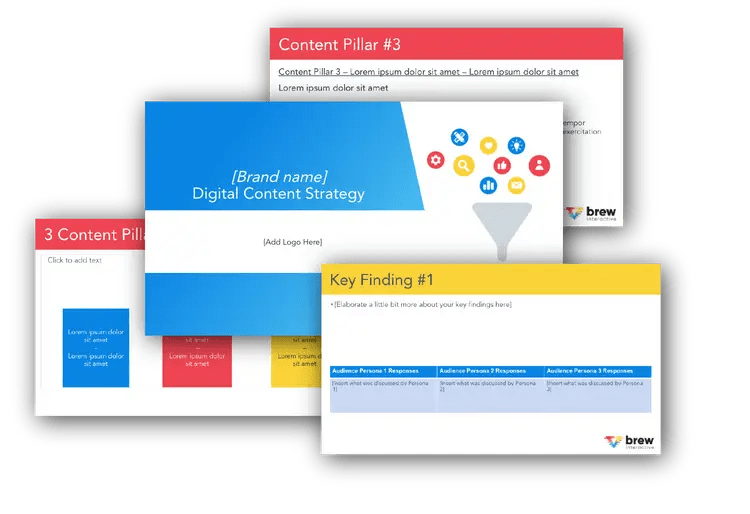
Free B2B Content Strategy Template
Not sure where to start when it comes to your content strategy? Struggling to gain traction? Grab our free B2B content strategy template to help you document your strategy.
Well designed and highly targeted ads get results.
The targeted digital advertising efforts paid off, resulting in a 288% increase in ROI, a 49% decrease in cost per lead, and a 118% increase in leads.
4. Social Media Marketing
Social media isn’t just for influencers and consumer brands. In fact, 75% of B2B buyers and 84% of C-Suite executives use social media when making a purchase.
Whether it’s through Facebook, Instagram, LinkedIn, Twitter, or Pinterest, social media marketing is a great way to engage with your audience and introduce them to your brand – without being intrusive with ads.
But many B2B marketers struggle to connect with their audience on social media, usually due to the lengthy buying cycle and nature of most B2B products and services.
How Many Companies Get Social Media Marketing Wrong
One of the biggest mistakes B2B marketers make through social media marketing is a failure to optimize for platform. They take a one-size-fits all across to social media, targeting the same audiences and pushing similar messaging across every platform.
They fail to understand that most business decision makers use different platforms with different goals and content preferences in mind. Emotional driven content isn’t likely to perform as well on LinkedIn, while highly technical and educational content might not make sense for Instagram. And publishing the same thing across all networks doesn’t solve the problem.
The second mistake many B2B companies make on social media is spending too much real estate talking about themselves. A few company-culture related posts may be beneficial, but no prospect wants to hear about each and every one of your company updates.
Lastly, many B2B companies fail to listen. Social media presents a great opportunity for conversation and community engagement. A strategy only focused on posting fails to take full advantage of the network.
Many B2B brands don’t listen for or engage with mentions of their brand
How to Get Social Media Marketing Right
The keys to getting the most out of social media marketing are platform optimization and community engagement.
Choose your platforms well and optimize your approach for each accordingly. Twitter is great for conversations and LinkedIn is perfect for peer-to-peer marketing. Instagram tends to perform better through visuals. Use a content calendar to plan your strategy by network.
Planning your content calendar is a critical part of successful social media marketing.
But in addition to the rather generic advice, get to know your target audience well on each platform. Test different types of content and measure network-specific engagement to determine what your prospects’ unique preferences are.
Finally, don’t be afraid to strike up a conversation. Listen for brand mentions, reply to comments, and don’t be afraid to comment on others’ posts. Take full advantage of the opportunity social media provides for conversations.
Dassault Systèmes approached the Brew Interactive team in hopes of better engaging their social media audience around SOLIDWORKS, one of their CAD brands.
The Brew team created ongoing content-based, creative moments to excite their community as well as make their brand more relevant to their audience. They catered each medium to its respective platform.
Illustration-based posts performed really well on Instagram
In addition, they sought to strike up conversations on social platforms to create unique touch points with the SOLIDWORKS audience.
Their social media marketing strategy grew Dassault Systèmes’ social presence by over 500,000 new followers across APAC and increased their engagement rate by 300%.
Many believe social metrics are mostly vanity, but this work resulted in a surge of leads as well, decreasing cost per lead by 50%.
5. Marketing Automation
Like many of our other channels, marketing automation is versatile. It can be used for everything from prospecting to closing deals.
Thanks to marketing automation platforms like Hubspot and Salesforce’s Pardot, B2B marketers are able to automate entire customer journeys based on customer triggers.
How Many Companies Get Marketing Automation Wrong
When it comes to marketing automation, most B2B companies fail to effectively align sales and marketing for maximum benefit. Many B2B marketers fall into the trap of believing a CRM + Marketing Automation software will solve all of their problems, so they fail to strategize appropriately.
Marketing teams are focused on MQLs while sales teams are focused on SQLs, but they’re not in alignment.
What happens with marketing automation is marketing teams configure lead scoring, and at times make the process to becoming an MQL far too easy.
Lead scoring can be an effective marketing automation feature, but only when marketing and sales are aligned on the appropriate attributes.
This results in still-cold contacts receiving automated, sales-focused emails far too early. The sales team might think they have a hot lead, but after a phone call realize they have no interest in the product or service.
When it comes to customer journeys, sales doesn’t find a seat at the table, leaving the marketing team to guess at what kinds of messaging and offers should be used to convert qualified leads.
How to Get Marketing Automation Right
Success in marketing automation lies in the collaboration between sales and marketing.
From the very beginning of a marketing automation campaign, sales teams and marketing teams need to be on the same page regarding what triggers will lead to what kind of content, how lead scoring will be managed, and when certain messages should be sent.
Sales and marketing alignment can lead to significant ROI.
All throughout the campaign, sales and marketing need to review performance and metrics together. They can’t be looked at in a silo. Information and data must flow back and forth in order to efficiently nurture quality leads through the funnel.
A great example of this kind of collaboration comes from HighQ, a U.K.-based enterprise cloud collaboration company. Their lengthy buying cycle made manual lead nurturing difficult and time consuming, so they began investing in marketing automation to nurture more efficiently.
When they first began utilizing marketing automation, sales and marketing were siloed. But they quickly realized the two must align to see success.
The sales team began providing feedback on lead quality and suggesting more relevant content delivery. The marketing team took sales’ feedback and adjusted their persona-targeted content strategy. The two teams also collaborated closely on lead scoring configuration to ensure sales was receiving high quality leads.
Thanks to their collaboration, email marketing campaigns have been performing incredibly well, with open rates near 50% and click rates near 20%.
6. Accounts Based Marketing (ABM)
Accounts Based Marketing isn’t necessarily a channel in itself, but a combination of many of the channels we’ve discussed, and a slightly different approach. It’s an omnichannel approach where marketing and sales teams collaborate to turn targeted accounts into customers.
Traditional lead generation marketing casts a wide net and uses advertising, content, and SEO to attract qualified buyers. Accounts Based Marketing flips this philosophy on its head and starts with targeting ideal customers, then launches personalized marketing campaigns to nurture and convert.
Accounts Based Marketing flips the traditional lead generation funnel upside down.
Where Many Companies Get Accounts Based Marketing Wrong
Many companies will approach an ABM campaign without a clear idea of who they need to be communicating with at their target account.
They may get a few email addresses from the target company without realizing none of their individual contacts are key decision makers. They send physical mail to the company, but it doesn’t make it past the front desk or the intern. So they feel like they’re building a relationship, but really they’re just engaging lower level management or the wrong side of the company.
It’s hard to notice this when the data shows opened emails and moderate engagement. Occasionally the contacts being targeted will pass along information, but most of the time the campaign stops with them.
I’ve worked at a company who ran an ABM campaign targeting a specific industry – but failing to engage our target decision makers. We invested fairly heavily in creative physical mailers. When we began connecting with contacts, we realized most of our mail hadn’t made it past the front desk.
This kind of ABM campaign can lead to loads of wasted spend and resources.
How to Get Accounts Based Marketing Right
One of the keys to accounts based marketing is knowing every decision maker at the table of your target account.
For example, a good ABM campaign might have the CEO receiving messaging about aligning their brand with a trustworthy and reliable partner. The CFO might get emails containing case studies covering proven ROI. And practitioners or specialists might get mailers with product or service features.
Successful campaigns know all parties involved in the buying decision.
In some instances, there is only one key decision maker. When this is the case, successful ABM marketers ensure that persona is well nurtured.
A great content marketing ABM example comes from Brew Interactive’s work with Enovatek. The team utilized ABM methods to expand their pool of prospects.
Rather than running campaigns to anyone at a target company, we identified the key decision maker to be the company’s Facility Manager. We leveraged third party tools to obtain a database of contact information, and launched them into a personalized email workflow.
ABM workflows have many steps and always make it easy to opt-out.
This ABM campaign played a significant role in lead generation from Enovatek, leading to a big time increase in revenue.
Don’t Just Check the Box
Many B2B marketers hear they need to be investing in a channel, so they make a couple hires our outsource to an agency, check the box, and carry on their way.
Don’t fall into this trap.
Avoid it by getting intimately familiar with your target personas, setting clear vision for your channels, and always testing.
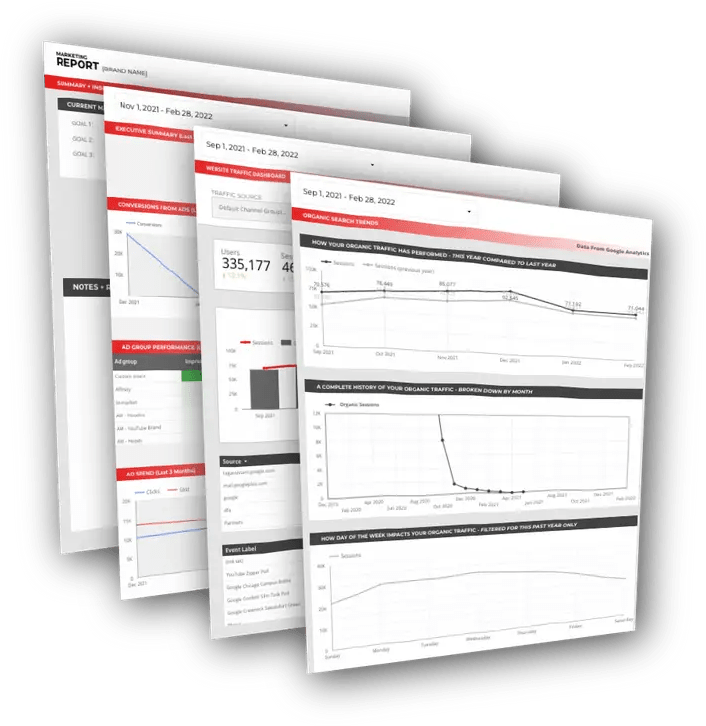
Free DataStudio Marketing Report
Improve your marketing reporting with our free DataStudio template that pulls data from Analytics, Google Ads, and Search Console to get a 360 degree view of your digital performance.





